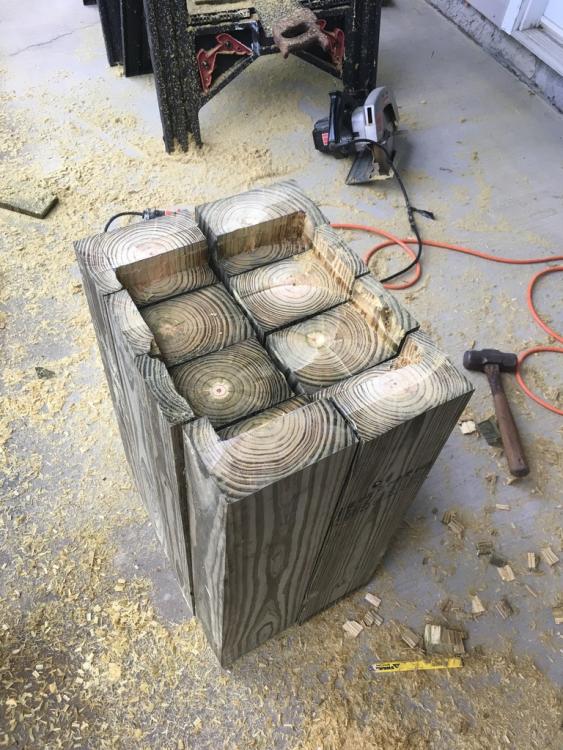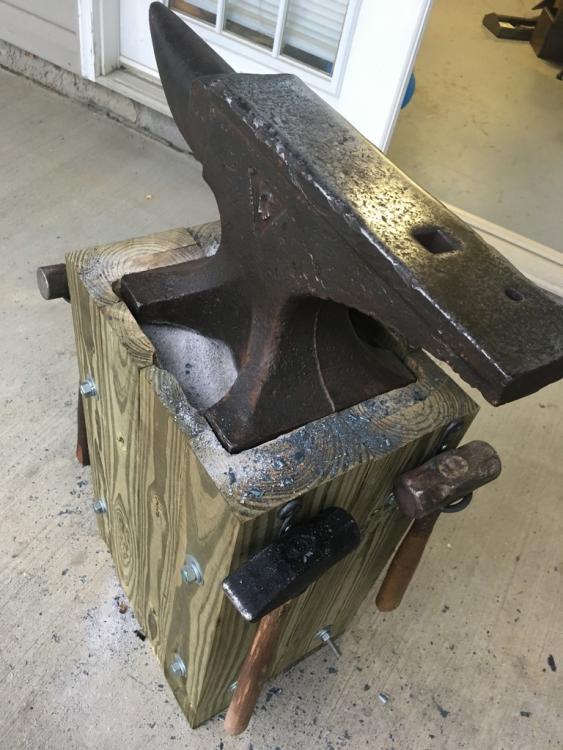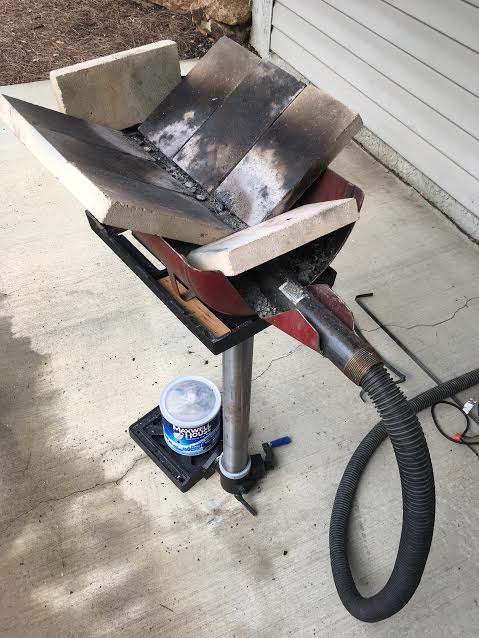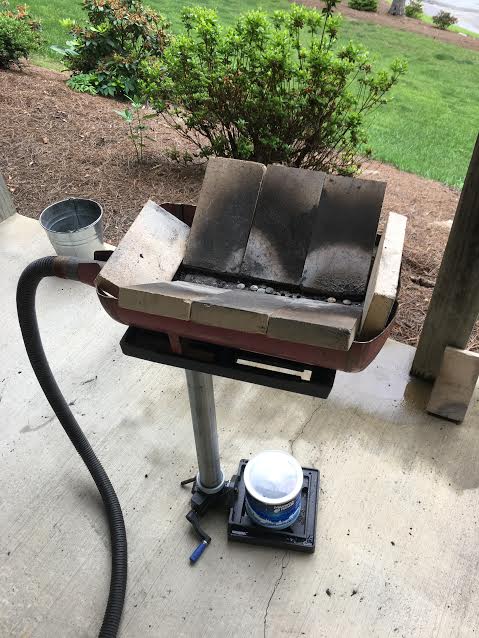
WNC Goater
Members-
Posts
84 -
Joined
-
Last visited
Content Type
Profiles
Forums
Articles
Gallery
Downloads
Events
Everything posted by WNC Goater
-
I hesitate to call this a "build". As you can see it's just some parts cobbled together. Half an old air tank, a pipe tuyere in the bottom. Then some sand and kitty litter with firebrick from Tractor supply laid on top. Old vacuum cleaner hose fits into the end of the pipe and a WalMart air mattress inflator supplies air at the other end. I hook that to an old sewing machine pedal. Step on it and it blows. Step off & it stops while you're pounding the steel. I've used it with charcoal. It can be used with wood scraps as well, just easier to tend the fire with charcoal. It will get hot enough to melt the steel. It's all atop an old drill press base and table. The Maxwell House can has a 25# bag of bird shot in it just to stabilize in case I bump into it but it's pretty stable without. Note I have bolts installed to block air holes. Those can be removed if I want a long fire. Maybe $20 excluding the air mattress inflator. Most of it was junk I had around.
-
Oh my, it scares me watching that aluminum bubble and boil like that. One "pop" and molten metal is spattered all over. Scary stuff.
-
Just thinking out loud here. The top of my timber anvil base is routed out about 1" deep. I pour some sand in there and seat the anvil in it. After a few minutes of hammering the anvil sits solid in there. Helps deaden the ring too. So for those timber stands mentioned that tend to rock a bit on a solid floor. Would it be feasible to do something like I did except on the opposite end. In other words, build a simple frame of 2x4 with a plywood base and pour in an inch or so of sand. Then sit the base in that, wiggle and twist to seat it, then with the anvil on top and a bit of hammering steel it would stop the rocking.
-
How to make a perfect forge weld, every time.
WNC Goater replied to Glenn's topic in Blacksmithing, General Discussion
Only Asian condiments will work per T.Powers. Soy for example. Not sure about Duck Sauce, Wasabi, Rice Wine, or various other condiments of Far East origination. I suppose they will work but I think TP wants to keep it a secret. Good advice! (see above) -
How to make a perfect forge weld, every time.
WNC Goater replied to Glenn's topic in Blacksmithing, General Discussion
Ahh, Asian brine quench. Who knew? -
Squirrel cooker finish help.
WNC Goater replied to Hephaestus Smith's topic in Blacksmithing, General Discussion
THAT is the truth and a large percentage of people looking for a reason. re. Stainless steel. I guess I was questioning how common it is for people to forge in SS. No doubt the typical modern consumer is going to choose SS/no care/dishwasher safe. I was specifically replying to the OP's forged pieces there that he was requesting a finish for. There are some who will choose hand forged because it is hand forged, assuming responsibility for taking care of it. No disagreement you are correct in that most would choose the no maintenance route. -
Squirrel cooker finish help.
WNC Goater replied to Hephaestus Smith's topic in Blacksmithing, General Discussion
+1 -
How to make a perfect forge weld, every time.
WNC Goater replied to Glenn's topic in Blacksmithing, General Discussion
We were talking blades, you're "screwing" up the conversation bringing corkscrews into the mix. Whole 'nuther set of rules. This whole thread has taken a "turn" for the worse & I think my brain is getting "twisted" up. Next thing you know someone will suggest pros and cons of bacon fat vs. beef tallow as a quenchant for tempering forged rebar samurai swords. -
Squirrel cooker finish help.
WNC Goater replied to Hephaestus Smith's topic in Blacksmithing, General Discussion
Not in agreement with the SS comment Pots and utensils and various cooking implements have been made from copper, aluminum, tin, steel, cast iron and who knows what all. I agree MOST mass produced stuff nowadays is stamped from SS but I don't think durability comes into the equation. Maybe I misinterpret what you mean. I also believe that the only allergy to bees wax is a contact dermatitis, not the same as anaphylactic shock allergy reaction. Bees wax is common in some skin care products and some people have a sensitivity to those products containing bees wax. -
How to make a perfect forge weld, every time.
WNC Goater replied to Glenn's topic in Blacksmithing, General Discussion
If you quench your blades on the summer or winter solstice, it won't warp. But only if the tip points north. It won't warp if pointed south either but it will get shorter. Trying to quench on the equinoxes results in warped blades. spring = right warp, fall = left warp...unless you're holding it upside down when it's plunged in the quench tank. In the event of a full moon on either equinoxes, the warp rule is null. The north-south rule is still in effect except opposite, it gets longer if pointed south. Oh wait, that sounded bad... Disregard, just point the blades north & all will be well. Pointing west results in a northward or right twist, pointing east results in a northward or left twist. So either west or east results in a left or right twist but always a northward twist. Warps are bad, twists are worse. -
Admittedly, I'm just beginning to experiment with solid fuel, usually using a propane forge. There are times when what I'm working on simply doesn't fit inside the propane forge. Coal isn't readily available locally, at least not to my knowledge so I've done some forging with charcoal, though I still have a experimental and rudimentary forge to burn it. I've forged using small chunks of raw wood, which works, all charcoal, and a mixture of each. I've got plenty of wood with which to make charcoal but thus far my procedure has been to build a fire in the firepit and shovel coals into a bucket of water and then spreading on a screen to dry. Not the most efficient means but it works. If I can find some coal, I doubt I'd go to the trouble of making charcoal. Even without, I cannot envision building some type of retort to make charcoal. I've read that "way back then" a full time forge would employ as many as 6 full time charcoal makers just to feed the forge. I can believe it as the small charcoal forge I have is a hungry little devil. I can also see where the local tree population around communities with multiple forges could start to become a bit "sparse"!
-
Following. Very interested in this very thing.
-
Squirrel cooker finish help.
WNC Goater replied to Hephaestus Smith's topic in Blacksmithing, General Discussion
I've finished a BBQ spoons and a steak flippers by running a wire wheel on an angle grinder after forging to remove scale, then wiping down with a liberal coating of canola oil and heating the object until smoking. Then let cool and wipe down with a clean cotton cloth. Of course, that is basically seasoning it. Seems to work okay and like a cast iron pot, after use and cleaning, a light wipe with vegetable oil or my personal preference, olive oil, will keep it in good shape. Some people will wipe it with bees wax while hot. That would be food safe but I havent personally tried beeswax. Dusty huh? We had that amount about three days last week, and the week before! -
Coal at local Tractor Supply
WNC Goater replied to Technician.Austin's topic in Solid Fuels: Coal, Coke, Charcoal, Wood, etc
That looks a whole lot like what I've rigged together for charcoal using firebrick and 1/2 an old air tank. -
Yes I'm aware of JB Weld. I was making a joke the tong reins mentioned by littleblacksmith were "welded" on with JB "Weld".
-
This is new to me so forgive any ignorance but couldn't the OP stuff a couple of those 5 gallon looking cans with lids in the background of his photos with wood, then build a fire in his pyramid and cook the wood in those cans? Looks like he could get about three of those in the pyramid (could be photo depth perception distortion) He would then only sacrifice to burning, the wood in the pyramid that is used to cook the wood in the cans. Also as I understand it, he would need to poke some holes for gas to escape in those cans.
-
Well it IS JB "WELD"
-
That's a fantastic price. I looked for months to try and find something under $5.00 a pound. I ended up with a 103 lb. Columbian for $450. I had to drive two hours for that! It is a cast steel anvil as well and rings like a bell. If yours rings loudly, put a magnet under the heel. It almost silences mine, amazing.
-
Okay I'm not suggesting this but curious...and asking as a newb as far as anvils so keep that in mind and feel free to label this as a stupid question. But, since this is a cast steel anvil and this is just an asthetics thing, what would happen if someone were to heat up something like (depending on width) a 3/16th or 1/4" mild steel rod, and hammered it down in there filling the crack, left it a bit proud, then after cooling hammered it on down flush to tighten it and allow a smooth surface? Would it loosen anyway once the filler cooled? What if any additional damage could it inflict?
-
The master Jeweler I trained under started out in Turkey, with little more than a blow pipe and two steel plates and a couple of hammers. Melt gold, hammer it out (just like blacksmith drawing out steel) then roll it between the two steel plates to make gold wire. Now we use oxy/gas torches, crucibles, ingot molds, carbide drawplates, hardened geared rolling mills, electric furnaces, even laser welders, Cad/cam & 3-D printers. Technology can make life easier or more productive. Different worlds, same results. But it is the mastery of the tools you have, rather than the tools themselves because still it comes down to a craftsman's eye and skill. In the video I'm intrigued by his mastery of his simple tools. I DID notice that big gear off to the side and he uses it @ around 2:25. But that rock, he knows well, even using the angles like an anvil horn. I'm also impressed with his frugality with his fuel! Here's another in that series of videos using a hammer as an anvil and apparently making a knifeblade:
-
I found a couple different styles of bifocal safety glasses on Amazon. I bought them originally for Mtn Biking to keep a limb or dirt out of my eyes but need reading glasses to read anything, including maps. Pretty cheap options too. I found a couple different styles of bifocal safety glasses on Amazon. I bought them originally for Mtn Biking to keep a limb or dirt out of my eyes but need reading glasses to read anything, including maps. Pretty cheap options too.
-
Actually the pipe I used to experiment with the fire brick is 1 1/2" and DOES have holes along its length, the thought at the time being, I needed that much airflow but additionally, as you said, I could use it for a long fire. As it was, it worked great but ate up a lot of fuel and I realized I didn't need that much airflow, that is unless there is a long piece that needs heating, I think I need to plug the holes, maybe by dropping a bolt in each. As Thomas pointed out, that may increase airflow out of the few holes left open. Thomas' idea of a plunger to block holes is also a thought....I can work on that. I feel I have hijacked this thread. Apologies to the OP.
-
Yes, decreasing air flow is what I intend. As far as durability, keeping in mind thus far I've only worked with a propane forge, it seems poking steel into the fire, and scraping and poking around with a poker manipulating the coals would invariably do damage to the configuration of the clay "pot". That's why I wondered about satanite or perhaps dry mortar mixed in with the natural clay/sand to make it harder and thus more durable. But maybe the clay/sand mixture is durable enough as is, I don't know. It is obviously adequate, just wondered if there was a way to make it long lasting. Or as long lasting as it can be considering the materials used. I realize eventually it will degrade and need to be broken out and rebuilt. I know my propane forge needs regular additions of satanite painted on over the koa wool to fill cracks and other damage caused by inserting steel and poking the walls. I assume a clay forge would too, and likely even more so. Just investigating how to minimize time spent in maintenance and constant "rebuilding" . Eventually I would like to build or buy a more traditional steel table/firepot coal forge in the future. This would be a start down that road. Just want it to be built the best I can with what I have.
-
So as a for instance, I could take half of an old air tank, put a pipe in the bottom with holes, then build and shape a "V" shaped profile of clay/sand/kitty litter in following the natural "U" shape of the half tank, and I'd be good to go? Would this work with coal/coke/charcoal? I ask because I have that half tank and have just placed a "V" of firebrick to try out with charcoal. It worked reasonable well though I need to block off some of the holes as the air supply was obviously more than I needed and it went through charcoal like a teenager through potato chips.
-
So a question. Can clay, whether local or kitty litter, and sand be combined with something like satanite or refractory cement and thus hardened into a durable shaped forge that will last? Admittedly, I haven't made a kitty litter/clay/ash forge or JABOD but my hesitancy has always been, it just seems like it wouldn't be durable. Seems satanite or refractory cement mixed in with the clay and sand would make a harder substance. But I'm sure I'm not the first to think of this so I assume there's some reason I've never seen it suggested ?




.jpg.7e4dc56e3c88a7aa90bc902a76e1c0ca.jpg)